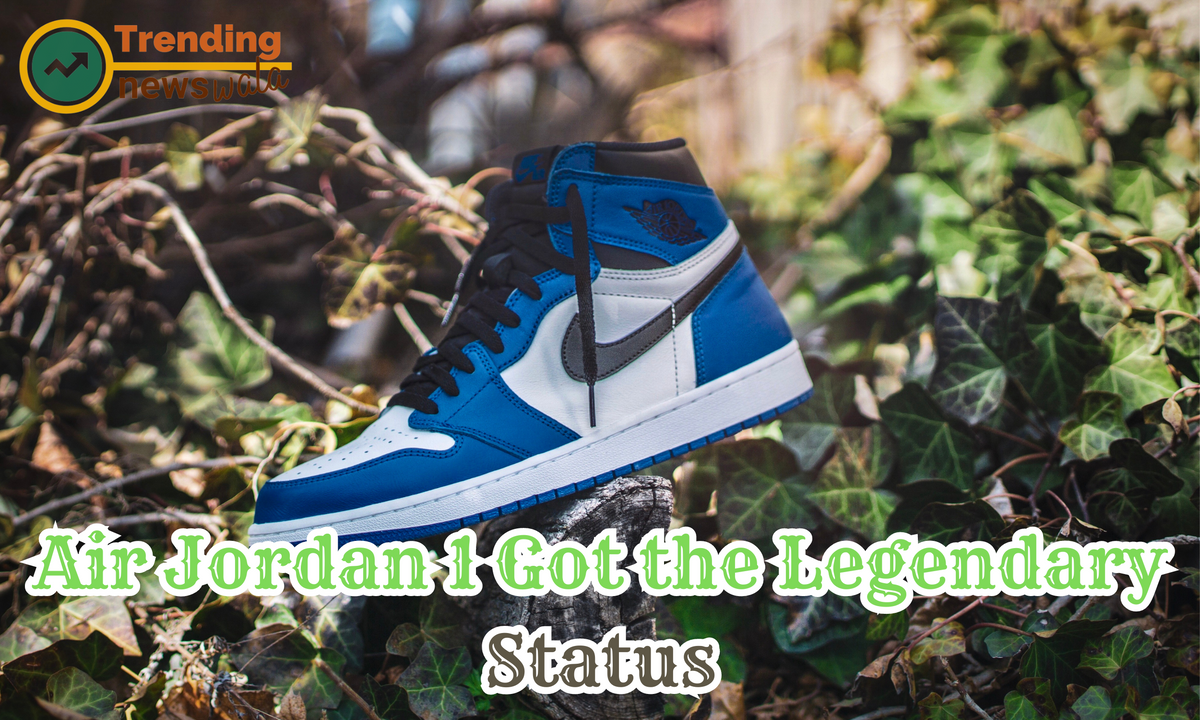How Air Jordan 1 Got the Legendary Status

In the world of sneakers, few names resonate as strongly as the Air Jordan 1. Born out of a groundbreaking collaboration between Nike and basketball legend Michael Jordan, the Air Jordan 1 has transcended its athletic origins to become a cultural icon. The journey of the Air Jordan 1 from its inception to achieving legendary status is a tale of innovation, rebellion, and a cultural revolution.
The Genesis of Air Jordan : The story begins in 1984 when Nike, already a leading athletic footwear brand, signed a rookie basketball player named Michael Jordan. Breaking away from the traditional white sneaker designs of the time, Nike envisioned a shoe that would not only revolutionize the basketball court but also redefine the sneaker culture.
Designed by Peter Moore, the Air Jordan 1 made its debut in the iconic "Bred" and "Chicago" colorways. The black and red "Bred" color scheme courted controversy as it violated the NBA's uniform policy, leading to fines every time Michael Jordan wore them on the court. This notoriety, however, only fueled the desire for the Air Jordan 1, creating an aura of rebelliousness around the sneaker.
The Banned Ad Campaign: One of the pivotal moments that propelled the Air Jordan 1 into legendary status was the "Banned" ad campaign. Nike capitalized on the fines incurred by Jordan, creating a commercial that showcased the rebellious spirit of the sneakers. The infamous tagline "On September 15, Nike created a revolutionary new basketball shoe. On October 18, the NBA threw them out of the game. Fortunately, the NBA can't stop you from wearing them," solidified the Air Jordan 1's identity as a symbol of defiance.
Cultural Impact Beyond the Court: As Michael Jordan soared to superstardom on the basketball court, the Air Jordan 1 transcended its athletic roots to become a fashion statement. The sneaker found favor not only among basketball enthusiasts but also within the burgeoning hip-hop and streetwear cultures. Celebrities and musicians began embracing the Air Jordan 1, further cementing its status as a symbol of coolness and success.
Iconic Colorways and Collaborations: The Air Jordan 1's legendary status was further solidified by its timeless and iconic colorways. From the classic "Bred" and "Chicago" to the stylish "Black Toe" and "Royal Blue," each release seemed to capture the imagination of sneaker enthusiasts. Limited-edition collaborations with renowned designers and artists, such as the Off-White x Air Jordan 1 by Virgil Abloh, added another layer of prestige to the sneaker.
Continued Relevance: Decades after its initial release, the Air Jordan 1 remains as relevant as ever. The sneaker continues to see new iterations, collaborations, and retros, ensuring that each release is met with unprecedented demand. Its timeless design and cultural significance have made the Air Jordan 1 a symbol of authenticity and a must-have for sneaker collectors and enthusiasts around the globe.
The Air Jordan 1's journey from the basketball court to a cultural phenomenon is a testament to its enduring appeal. Its impact on sports, fashion, and pop culture has solidified its place in sneaker history. The Air Jordan 1 is more than just a pair of shoes; it represents a lifestyle, a symbol of individuality, and an enduring legacy that continues to inspire generations of sneaker enthusiasts worldwide. As the Air Jordan 1 continues to evolve and capture the imagination of fans, its legendary status is destined to endure for years to come.
The Genesis of Air Jordan

The genesis of Air Jordan can be traced back to the early 1980s when Nike, the iconic sportswear brand, was on the lookout for a game-changing partnership that would revolutionize the sneaker industry. The turning point came in 1984 when a young and promising basketball talent named Michael Jordan entered the scene.
The Nike-Michael Jordan Partnership: In 1984, Nike signed a groundbreaking endorsement deal with Michael Jordan, a rookie from the University of North Carolina who had just entered the NBA. This collaboration was destined to reshape the landscape of basketball sneakers and athletic endorsements.
Designing the Air Jordan 1: Peter Moore, a renowned designer, was tasked with creating a signature sneaker for Michael Jordan. The result was the Air Jordan 1, a high-top basketball shoe that defied the conventional designs of its time. Its bold color blocking and innovative use of materials set it apart from other sneakers on the market.
Breaking the Mold: The Air Jordan 1 was a departure from the typical white sneakers that dominated the basketball court. The design was a bold statement, featuring a black and red colorway, challenging the norms of uniformity set by the NBA. This rebellious spirit set the stage for the sneaker's unique journey.
The Banned Story: The Air Jordan 1 courted controversy and gained immense attention when it was banned by the NBA. The black and red color scheme violated the league's uniform policy, leading to fines every time Michael Jordan wore them on the court. The ban, however, became a marketing opportunity, creating a narrative of defiance and rebellion.
Launching the Legend: The Air Jordan 1 was officially released to the public in 1985, and its reception was nothing short of revolutionary. The sneaker quickly became a cultural phenomenon, transcending its basketball roots to become a fashion icon. The "Bred" (Black/Red) and "Chicago" colorways gained legendary status, solidifying the Air Jordan 1 as a symbol of style and rebellion.
Innovations in Sneaker Culture: The Air Jordan 1 introduced several innovations to sneaker culture, including the iconic "Wings" logo and the Jumpman logo, both of which have become synonymous with the Air Jordan brand. The design and marketing strategies employed for the Air Jordan 1 set the blueprint for future sneaker releases and collaborations.
Cultural Impact: Beyond its performance on the basketball court, the Air Jordan 1 had a profound impact on popular culture. It became a staple in the emerging hip-hop and streetwear scenes, with celebrities and musicians adopting the sneaker as a symbol of coolness and success.
Legacy and Continued Success: The success of the Air Jordan 1 paved the way for an entire line of Air Jordan sneakers. Each subsequent release continued to build on the legacy established by the inaugural model, with new colorways, collaborations, and innovations.
In conclusion, the genesis of Air Jordan can be attributed to a perfect storm of athletic prowess, innovative design, and strategic marketing. The Air Jordan 1, born out of the partnership between Nike and Michael Jordan, not only redefined basketball footwear but also left an indelible mark on sneaker culture and fashion, earning its place as one of the most iconic and legendary sneakers of all time.
The Banned Ad Campaign

The "Banned" ad campaign is a crucial chapter in the history of the Air Jordan 1, marking a pivotal moment that contributed significantly to the sneaker's legendary status. The campaign not only addressed the NBA's ban on the black and red Air Jordan 1 but turned the restriction into a powerful marketing tool, adding an element of rebellion and controversy to the brand.
Background of the Ban: The NBA banned the Air Jordan 1 due to a violation of uniform regulations. The black and red colorway of the sneakers did not comply with the league's policy, which mandated that players' shoes must match their team's colors. Michael Jordan, undeterred by the fines imposed for wearing the banned sneakers on the court, continued to lace up the Air Jordan 1, sparking widespread attention and curiosity.
Creation of the "Banned" Ad Campaign: Nike seized the opportunity presented by the ban and transformed it into a marketing campaign. The "Banned" ad, released in 1985, featured Michael Jordan and the Air Jordan 1 in a bold and rebellious light. The commercial aimed to turn the ban into a badge of honor, portraying the sneakers as revolutionary and challenging the status quo.
Narrative of Defiance: The ad campaign crafted a narrative of defiance and nonconformity. It highlighted the rebellious nature of Michael Jordan, positioning him as a trailblazer who was unafraid to challenge authority. The tagline of the ad read, "On September 15, Nike created a revolutionary new basketball shoe. On October 18, the NBA threw them out of the game. Fortunately, the NBA can't stop you from wearing them."
Cultural Impact: The "Banned" campaign resonated beyond the world of sports, capturing the imagination of consumers and creating a cultural phenomenon. The ban and subsequent marketing efforts contributed to the mystique surrounding the Air Jordan 1, turning it into a symbol of rebellion and individuality.
Reinforcing Authenticity: The ban, rather than hindering the success of the Air Jordan 1, reinforced its authenticity and cultural significance. The sneakers became a symbol of standing out, breaking the rules, and expressing one's unique style. This authenticity resonated with consumers, fueling the popularity of the Air Jordan line.
Marketing Strategy: Nike's decision to embrace the ban as a marketing opportunity showcased the brand's strategic acumen. It transformed what could have been a setback into a defining moment, creating a narrative that not only sold sneakers but also built a brand ethos around individuality and pushing boundaries.
Legacy of the "Banned" Campaign: The "Banned" ad campaign left an enduring mark on sneaker culture. It demonstrated the power of storytelling in marketing and established the Air Jordan brand as more than just a sports product. The legacy of the "Banned" campaign continues to influence the marketing strategies of sneaker brands and remains an iconic moment in the history of athletic footwear.
In summary, the "Banned" ad campaign played a crucial role in shaping the narrative around the Air Jordan 1, turning a ban into a symbol of defiance and authenticity. The campaign's impact reverberates through the cultural and marketing legacy of the Air Jordan brand, contributing to its legendary status in the world of sneakers.
Iconic Colorways and Collaborations

The Air Jordan 1's journey to legendary status is not only defined by its groundbreaking design but also by its iconic colorways and collaborations. From classic releases to limited editions crafted in collaboration with renowned designers, the Air Jordan 1's color palette has played a pivotal role in shaping its cultural significance and desirability.
"Bred" (Black/Red): The original colorway of the Air Jordan 1, the "Bred" (Black/Red), holds a special place in sneaker history. The black and red combination not only defied the traditional white-dominated basketball sneaker landscape but also gained notoriety due to the NBA's ban on the color scheme. Despite the ban, Michael Jordan continued to wear the iconic sneakers, turning them into a symbol of rebellion and individuality.
"Chicago": The "Chicago" colorway is another quintessential release that has become synonymous with the Air Jordan 1. Featuring a clean white leather upper with red accents on the swoosh, collar, and outsole, the "Chicago" colorway represents the Bulls' team colors and is widely celebrated for its simplicity and timeless appeal.
"Royal Blue": The "Royal Blue" colorway is characterized by a striking combination of royal blue and black. Released alongside the "Bred" and "Chicago" colorways in 1985, the "Royal Blue" version quickly became a fan favorite. Its bold and vibrant design has made it a sought-after classic in the Air Jordan 1 lineup.
Collaboration with Virgil Abloh - Off-White x Air Jordan 1: In 2017, Nike partnered with fashion designer Virgil Abloh for "The Ten" collaboration, which included a deconstructed and reimagined version of the Air Jordan 1. The Off-White x Air Jordan 1 featured bold design elements, including an exposed foam tongue, quotation marks, and a zip tie. This collaboration not only elevated the Air Jordan 1's status but also demonstrated its enduring influence in the realm of fashion.
"Shattered Backboard": The "Shattered Backboard" colorway pays homage to a moment in Michael Jordan's career when he shattered a glass backboard during a 1985 exhibition game in Italy. The sneakers feature a unique blend of orange, black, and white, creating a color scheme inspired by the uniform Jordan wore during the historic moment.
"Black Toe": The "Black Toe" colorway combines black, white, and red, with a distinctive black toe box that extends to the heel. This classic design has been featured in several iterations, including the "Black Toe" itself and variations like the "Bred Toe."
Collaboration with Travis Scott - Travis Scott x Air Jordan 1: The collaboration with rapper Travis Scott produced an Air Jordan 1 that blended elements of the iconic "Chicago" colorway with unique details. Featuring a backward swoosh, a hidden stash pocket, and Scott's signature Cactus Jack branding, the Travis Scott x Air Jordan 1 became an instant collector's item.
"UNC" (University Blue): The "UNC" colorway pays tribute to Michael Jordan's alma mater, the University of North Carolina. Characterized by a combination of university blue and white, this colorway reflects Jordan's college basketball roots and has gained popularity among sneaker enthusiasts.
Collaboration with Dior - Dior x Air Jordan 1: The collaboration between Jordan Brand and the luxury fashion house Dior resulted in a limited-edition Air Jordan 1. Featuring a subtle gray and white colorway with the Dior logo, the Dior x Air Jordan 1 is a testament to the crossover between streetwear and high fashion.
"Pine Green" and "Court Purple": These colorways, along with others like "Shadow" and "Banned," contribute to the extensive palette of the Air Jordan 1. The use of different hues and materials in these releases showcases the sneaker's versatility and the brand's ability to continually reinvent its classic silhouette.
In summary, the Air Jordan 1's iconic colorways, ranging from the classic "Bred" and "Chicago" to innovative collaborations with designers like Virgil Abloh and luxury brands like Dior, have played a crucial role in establishing its legendary status. Each colorway tells a story, whether rooted in Michael Jordan's career moments, historical events, or creative collaborations, contributing to the enduring allure and cultural impact of the Air Jordan 1.

In the dynamic world of athletic footwear, one silhouette stands out as an icon, transcending its origins on the basketball court to become a cultural phenomenon—the Air Jordan 1. How did this sneaker, born out of a collaboration between Nike and a young Michael Jordan, evolve from a revolutionary design to a legendary status that spans generations? Let's delve into the journey of The Air Jordan 1 and explore the factors that contributed to its enduring and legendary appeal.
A Game-Changing Partnership: The genesis of the Air Jordan legend lies in the collaboration between Nike and Michael Jordan in 1984. At the time, Nike was a powerhouse in the athletic footwear industry, and the signing of Michael Jordan marked the beginning of a new era. Nike aimed to create a signature shoe for the basketball prodigy that would not only enhance his on-court performance but also redefine the aesthetics of basketball sneakers.
Design Innovation: Enter Peter Moore, the designer tasked with crafting the inaugural Air Jordan. The Air Jordan 1 shattered conventions with its bold design, high-top silhouette, and a color palette that defied the norms of basketball footwear. The "Bred" (Black/Red) colorway, featuring the now-iconic swoosh, instantly made a statement—this was no ordinary sneaker.
Banned, Yet Embraced: The NBA's ban on the black and red Air Jordan 1 for violating uniform regulations proved to be a turning point. Rather than hindering its success, the ban fueled curiosity and controversy, creating a narrative of rebellion that would become synonymous with the Air Jordan brand. Michael Jordan's defiance and continued wear of the banned sneakers turned them into a symbol of individuality.
The Banned Ad Campaign: Nike seized the opportunity presented by the ban and transformed it into a marketing triumph. The "Banned" ad campaign, featuring Michael Jordan and the iconic tagline, "The NBA can't stop you from wearing them," turned restriction into desirability. The campaign played a pivotal role in establishing the Air Jordan 1 as a sneaker with a rebellious spirit and a story to tell.
Cultural Impact and Beyond Basketball: As Michael Jordan's star rose on the basketball court, the Air Jordan 1 transcended its athletic roots to become a cultural phenomenon. The sneaker found a place in the burgeoning hip-hop and streetwear scenes, embraced by musicians and influencers. The Air Jordan 1 became a symbol of coolness, self-expression, and a lifestyle beyond the basketball court.
Iconic Colorways and Collaborations: The Air Jordan 1's legendary status is further etched through its iconic colorways. From the classic "Chicago" and "Bred" to collaborations with designers like Virgil Abloh and luxury brands like Dior, each release tells a unique story and adds layers to the sneaker's cultural significance.
Legacy and Continued Reinvention : Decades after its debut, the Air Jordan 1's legacy endures. The sneaker continues to captivate sneaker enthusiasts, with each release met with unparalleled demand. The Air Jordan 1's ability to reinvent itself while staying true to its roots speaks to its timelessness and cultural relevance.
The Air Jordan 1's journey from a daring design to a symbol of rebellion and cultural zeitgeist is a testament to its impact on the world of sneakers. Its legendary status isn't merely about its performance on the basketball court; it's a tale of defiance, innovation, and cultural resonance. The Air Jordan 1 isn't just a sneaker; it's a symbol of authenticity, storytelling, and a legacy that continues to evolve with each new chapter in sneaker history.

What is the origin of the Air Jordan 1?
The Air Jordan 1 originated from the collaboration between Nike and basketball legend Michael Jordan in 1984. It was designed by Peter Moore, aiming to create a signature shoe that would redefine basketball footwear.
Why is the "Bred" (Black/Red) colorway significant for the Air Jordan 1's legendary status?
The "Bred" colorway is the original color scheme of the Air Jordan 1 and gained notoriety due to the NBA's ban on its black and red design. This ban, rather than hindering its success, contributed to the sneaker's rebellious image and cultural significance.
What role did the banned ad campaign play in the Air Jordan 1's legacy?
The banned ad campaign turned the NBA's ban into a marketing opportunity. Featuring Michael Jordan and the tagline "The NBA can't stop you from wearing them," the campaign transformed the ban into a symbol of defiance, adding to the sneaker's allure.
How did the Air Jordan 1 transcend its basketball roots to become a cultural phenomenon?
Michael Jordan's rising star on the basketball court, coupled with the rebellious image of the Air Jordan 1, led to its adoption in the hip-hop and streetwear cultures. The sneaker became a symbol of coolness and self-expression beyond the basketball arena.
What are some iconic colorways of the Air Jordan 1?
Iconic colorways include the "Chicago," "Royal Blue," "Shattered Backboard," and "UNC" (University Blue). Each colorway has its unique story and contributes to the sneaker's legendary status.
How did collaborations impact the Air Jordan 1's cultural significance?
Collaborations with designers like Virgil Abloh (Off-White x Air Jordan 1) and luxury brands like Dior elevated the Air Jordan 1's status in the fashion realm. These collaborations added creative elements and unique designs, further contributing to its cultural impact.
Why is the Air Jordan 1 considered timeless?
The Air Jordan 1's timeless appeal lies in its ability to adapt and reinvent itself while maintaining its original design ethos. Its cultural resonance, authenticity, and continued popularity among sneaker enthusiasts contribute to its enduring legacy.
How has the Air Jordan 1 continued to evolve over the years?
Decades after its debut, the Air Jordan 1 continues to see new releases, collaborations, and iterations. Its ability to stay relevant while honoring its heritage showcases its adaptability and continued influence in sneaker culture.
What makes the Air Jordan 1 more than just a sneaker?
The Air Jordan 1 is more than a sneaker; it's a symbol of authenticity, storytelling, and a lifestyle. Its impact extends beyond sports footwear, embodying cultural shifts, self-expression, and a legacy that resonates with diverse audiences.
Why is the Air Jordan 1 considered a cultural icon?
The Air Jordan 1 is considered a cultural icon due to its influence on fashion, music, and street culture. Its rebellious image, timeless design, and association with Michael Jordan's legacy have solidified its status as a symbol of authenticity and cultural significance.





